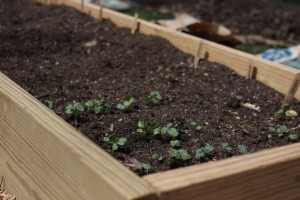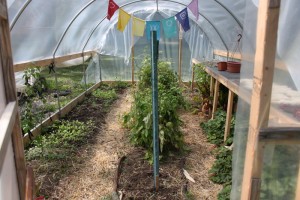The funny thing about year-round growing, which we're attempting, is that the gardening season doesn't ever really end. I'm still watering plants in the hoop house and covering and uncovering cabbages and broccoli's to earn a harvest during the holidays. But I'll address our fall plantings in a different post. Today's is about the regular season, the April to October produce.

Garden Overview
We have five types of gardens: about 150 row feet of 30-inch wide outdoor beds (one raised with wooden sides, the rest raised by land shaping), two 20-foot hugelkultur piles (which I'll review in a separate post), three large beds (one of which is Lil's) totaling about 1000 square feet, three 20-foot 18-inch rows in the hoop house, and 30 trees of various edible types including pear, plum, apple, peach, cherry, and nut. All together that is...a lot of growing space. You can do the math if you want.
I was certain that this year was going to be a total failure because I expected excessive deer pressure and was uncertain about the quality of the soil and water drainage. As it turned out, my pessimism was unwarranted and the garden yielded hundreds of meals of produce.
We had a general plan for the beds but when the time came to plant, we defaulted to our standard 'plant what's available', which means all the strong seedlings I grew plus leftover seedlings from Swainway Urban Farm plus whatever else looked interesting. We intentionally interspersed varieties in different locations to maximize production if one bed or another failed for some reason.
What Worked
We planted seeds for peas, kale, mustard, lettuce, cilantro, beets, radishes and swiss chard in the hoophouse in late March. The greens all gave us many cuttings until late May when days became too hot and greens bolted. We enjoyed solid harvests of beets and radishes through June.
My sister, mother and I planted 20 feet of organic seed potatoes and 20 feet of sprouted organic grocery store potatoes in a slightly shady location. They thrived and we began harvesting them in mid-June. All varieties (the seed and the grocery store) produced at least ten big potatoes from each plant. They provided all our potato needs from June through September, feeding friends and family many times.
I scattered tomato, pepper, and eggplant seedlings all over the garden. While this became a staking nightmare, wherever I kept the plants off the ground, they produced very well.
We tucked sweet potato slips in under some tomatoes and rhubarb. They gave us one huge tuber and a couple little ones per plant, which isn't bad for an afterthought of an under crop.
Carrots thrived in many locations. As they're Lil's favorite vegetable and have almost no pests, carrots became one of my favorite crops this year.
My little kitchen herb garden of perennials is well established now at the end of the season. They are tucked into a sunny South-facing spot alongside the garage, so hopefully many of them will last through the winter.
We were able to harvest about 3 bushels of apples from our ancient apple tree in the back. I love free food and can't wait until the rest of the orchard matures.
Flowers, flowers, flowers. This was the year that I embraced the beauty of flowers, for which I mostly thank Lil. She grew a dozen varieties in her garden and I tucked blooms into corners of rows too. We made a big patch of sunflowers and zinnias too.
Straw mulching rows and walk paths worked beautifully to keep down weeds. More on this another time.
What Didn't Work
We planted onion sets at the outside of a bed containing beets. They didn't form big bulbs in that space of neglect, leading me to think we need to dedicate an entire bed to them next year.
Cabbages and collards were a wash. We did harvest about ten heads of cabbage but it was very buggy because I couldn't stay on top of the cabbage moth caterpillars. I wish there were a way to grow cabbage in the chicken run because the hens LOVE cabbage moths caterpillars...but they also love cabbage greens.
The broccoli and cauliflower I grew from seed never thrived and produced big heads. Plus, they were yet another breeding ground for cabbage moths. One idea for next year is to grow these under a light row cover so the cabbage moths can't lay eggs on them. Or maybe attract some predators?
Though the hoop house produced beautiful early greens and peas, the heat in there stopped growing before the time that outdoor greens are sweet. But because I didn't plant any outside, I didn't have greens in late spring when I wanted them. Next year, I'm planting them outside three weeks after the hoop house.
Alex tilled and I hand-hoed a big bed in the front of the yard to plant grains and squashes. The idea was to plant seeds and forget about them, which we did. Unfortunately, the tilling and hoeing only stirred up weed seeds and the plot was overrun with weeds that hid the squash bugs too. The squashes were a near total loss and the sweet corn never was super sweet. We ended up harvesting those dry for corn meal. We did harvest fifty volunteer butternut-ish squash from another bed.
Conclusions
We're left with the following ideas:
- plant more potatoes and sweet potatoes
- put the tomatoes and peppers in rows so they can be staked with florida weave style
- plant more carrots, especially under the tomatoes
- pay attention to where the onions go
- figure out a way to conquer the cabbage moths
- follow up hoop house plantings with outdoor plantings of spring greens and veggies
- keep up with straw mulching
- take more pictures - it was a struggle to find these!
How did your garden grow this year?
PS. This is the first post in November, a month in which I'll attempt to write every day. Prepare your RSS readers and throw me topic ideas if you have any!


